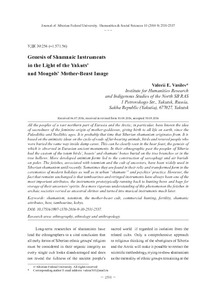Genesis of Shamanic Instruments in the Light of the Yakuts’ and Mongols’ Mother-Beast Image
Скачать файл:
URI (для ссылок/цитирований):
https://elib.sfu-kras.ru/handle/2311/26385Автор:
Vasilev, Valerii E.
Васильев, В.Е.
Дата:
2016-10Журнал:
Журнал Сибирского федерального университета. Гуманитарные науки. Journal of Siberian Federal University. Humanities & Social Sciences;2016 9 (10)Аннотация:
All the peoples of a vast northern part of Eurasia and the Arctic, in particular, have known the idea of sacredness of the feminine origin of mother-goddesses, giving birth to all life on earth, since the Paleolithic and Neolithic ages. It is probably that time that Siberian shamanism originates from. It is based on the animistic ideas on the cycle of souls of fur-bearing animals, birds and revered people who were buried the same way inside damp caves. This can be clearly seen in the bear feast, the genesis of which is observed in Eurasian ancient monuments. In their ethnographic past the peoples of Siberia had the custom of the totem birds’, beasts’ and shamans’ bones burial on the tree branches or in the tree hollows. More developed animism forms led to the construction of sarcophagi and air burials on poles. The fetishes, associated with totemism and the cult of ancestors, have been widely used in Siberian shamanism until recently. Sometimes they are found in their relic and transformed form in the ceremonies of modern holidays as well as in urban “shamans’” and psychics’ practice. However, the fact that remains unchanged is that tambourines and stringed instruments have always been one of the most important attributes, the instruments prototypically running back to hunting bows and bags for storage of their ancestors’ spirits. In a more rigorous understanding of this phenomenon the fetishes in archaic societies served as ancestral shrines and turned into musical instruments much later У всех народов широкой северной полосы Евразии и, в частности, Арктики идея сакральности женского начала богинь-матерей, порождающих всё живое на Земле, была известна с эпохи палеолита и неолита. Вероятно, именно с той поры берёт начало и сибирское шаманство, в основе которого лежали анимистические представления о круговороте душ промысловых зверей, птиц и почитаемых людей, схожим образом хоронимых внутри сырых пещер, что отчётливо видно в медвежьем празднике, генезис которого наблюдается в древнейших памятниках Евразии. В этнографическом прошлом у народов Сибири существовал обычай погребения костей тотемных птиц, зверей и шаманов на ветвях или в дуплах растущих деревьев. Более развитые формы анимизма привели к сооружению саркофагов и воздушных погребений на столбах. В сибирском шаманстве фетиши, связанные с тотемизмом и культом предков, широко применялись до недавних пор. Иногда они в пережиточной, трансформированной форме встречаются в церемониях современных праздников, а также в практике разных городских «шаманов» и экстрасенсов. Но неизменным остаётся то, что одним из самых важных атрибутов всегда выступают бубны и смычковые или струнные инструменты, восходящие к прототипам как охотничьи луки и мешки для хранения духов предков. В более строгом понимании данного феномена эти фетиши в архаических обществах служили родовыми святынями и лишь гораздо позднее превратились в музыкальные инструменты
Коллекции:
Метаданные:
Показать полную информациюСвязанные материалы
Показаны похожие ресурсы по названию, автору или тематике.
-
Structural Components of the Shamanic Rite of Tungusic Peoples in the Far East of Russia (on the Problem of Musical and Stylistic Specificity)
Mezentseva, Svetlana V.; Мезенцева, С.В. (Сибирский федеральный университет. Siberian Federal University, 2016-06)The subject of the work is a shamanic rite of the Tungusic peoples of the Far East of Russia. The purpose of the work is to highlight the main structural components of the shamanic rite in terms of musical and stylistic ... -
Шаманская личная сказка в генезисе нанайского героического эпоса
Булгакова, Т. Д.; Bulgakova, Tatiana D. (Сибирский федеральный университет. Siberian Federal University, 2023-11)Личные сказки представляют собой рассказы шаманов о событиях, пережитых и переживаемых каждым из них в пространстве духовного мира, о преодолеваемых ими в этом пространстве препятствиях и об их отношениях с духами-пом ... -
Religion and Cultural Interaction in the Republic of Buryatia
Amogolonova, Darima D.; Sodnompilova, Marina M.; Амоголонова, Д.Д.; Содномпилова, М.М. (Сибирский федеральный университет. Siberian Federal University, 2016-04)The paper discusses the processes of interaction between religious groups and institutions in post soviet Buryatia in the context of a religious revival in Russia. The authors argue that swift return of religiosity from ... -
Становление этнической идентичности в Сибири: роль традиций и современных институтов
Булгакова, Т.Д.; Bulgakova, Tatiana D. (Сибирский федеральный университет. Siberian Federal University., 2015-02)«Современный дискурс о необходимости возрождения полузабытых традиций коренных народов Сибири в контексте актуализации их этнической идентичности парадоксальным образом противоречит наблюдаемому исследователями феномену ... -
Interpretation of the Buryat Heroic Epic in the Libretto of Zh. Batuev’s Ballets “Geser” and “The Son of the Earth”
Kolpetskaia, Olga Iu.; Колпецкая, О.Ю. (Сибирский федеральный университет. Siberian Federal University., 2016-01)This paper examines examples of professional choreographic art of Buryatia – Zhigzhit Batuev’s ballets “Geser” (1967) and “The Son of the Earth” (1972), created on the basis of national heroic epic (üliger). Connecting ...

